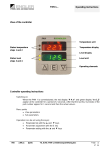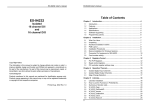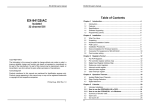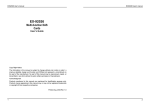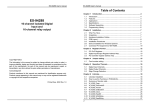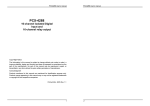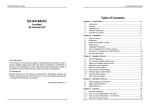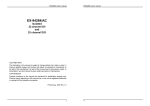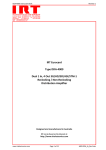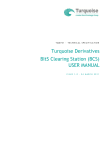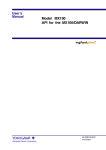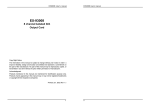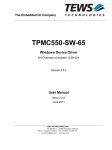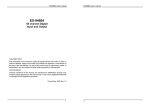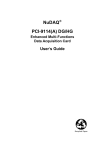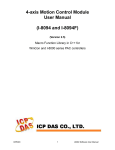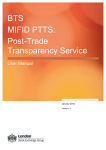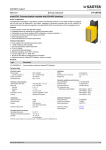Download Manual - TopsCCC
Transcript
EX92016 User’s manual EX92016 User’s manual EX-92016 16 channel Isolated Analog input card Copy Right Notice The information in this manual is subject to change without prior notice in order t o improve reliability, design and function and DOSed not represent a commitment on the part of the manufacturer. No part of this manual may be reproduced, copied, or transmitted in any form without the prior written permission of manufacturer. Acknowledgment Products mentioned in this manual are mentioned for identification purpose only. Products manes appearing in this manual may or may not be registered trademarks or copyright of their respective companies Printed Jan. 2003 Rev 1.1 1 2 EX92016 User’s manual Chapter 6 Operation Theorem..........................................................................34 Table of Contents Chapter 1 Introduction ..................................................................................... 7 1.1 1.2 1.3 1.4 1.5 Introduction ............................................................................................... 8 The block diagram of EX-92016................................................................ 9 Specifications ............................................................................................ 10 Software Supporting.................................................................................. 11 Programming Library................................................................................. 11 Chapter 2 Installation ....................................................................................... 13 2.1 2.2 2.3 2.4 2.5 2.6 What You Have ......................................................................................... 14 Unpacking ................................................................................................. 14 Hardware Installation Outline .................................................................... 14 PCB Layout............................................................................................... 15 Installation Procedures.............................................................................. 16 Device Installation for Windows Systems.................................................. 16 Chapter 3 Signal Connections ........................................................................ 17 3.1 3.2 Digital I/O connector.................................................................................. 18 Timer/Counter connector .......................................................................... 19 Chapter 4 Jumper settings .............................................................................. 21 4.1 4.2 4.3 4.4 4.5 Card number setting ................................................................................. 22 Analog input type selection ....................................................................... 23 Input polarity selection .............................................................................. 23 Full Range selection.................................................................................. 24 Input Range Configurations ...................................................................... 24 Chapter 5 Registers Format............................................................................. 25 5.1 5.2 5.3 5.4 5.5 5.6 5.7 5.8 5.9 5.10 5.11 5.12 5.13 5.14 EX92016 User’s manual PCI PnP Registers .................................................................................... 26 PCI controller register address map.......................................................... 26 Digital Input Register Address Map ........................................................... 27 Digital Output Register .............................................................................. 27 Read FIFO data register ........................................................................... 27 Read FIFO status register......................................................................... 28 A/D control register ................................................................................... 28 A/D control status register......................................................................... 29 Interrupt Control and Readback Register.................................................. 29 Software Trigger Register ......................................................................... 30 Hardware Interrupt Clear Register ............................................................ 30 Clear scan register .................................................................................... 30 Timer/Counter Register............................................................................. 31 High Level Programming........................................................................... 31 3 6.1 6.2 6.3 6.4 6.5 6.6 6.7 Isolated Digital Input Channels ..................................................................35 Isolated Digital Output Channels ...............................................................36 A/D Signal Source Control .........................................................................37 A/D Trigger Source Control ........................................................................40 A/D Data Transfer Modes ..........................................................................40 Interrupt Control .........................................................................................41 Timer/Counter Operation ...........................................................................42 Chapter 7 Libraries............................................................................................44 7.1 7.2 7.2.1 7.2.2 7.3 7.4 7.5 7.6 7.7 7.8 7.9 7.10 7.11 7.12 7.13 7.14 7.15 7.16 7.17 7.18 7.19 7.20 7.21 7.22 7.23 7.24 7.25 7.26 7.27 7.28 4 Libraries Installation ...................................................................................45 Libraries Installation ...................................................................................45 How to use the DOSDAQH.LIB in DOS .....................................................45 How to use the PCIDAQ.DLL s in Windows ...............................................46 Summary of function calls ..........................................................................47 Open card ..................................................................................................49 Get Card’s number ....................................................................................50 Get driver version ......................................................................................51 Get PCI Bus and Slot number....................................................................52 Close card..................................................................................................53 Read digital input data ...............................................................................54 Write data to digital output port ..................................................................55 Read back digital output data ....................................................................56 Set bit of digital output port ........................................................................57 Reset bit of digital output port ....................................................................58 Initialize AD triggered by software ..............................................................59 Single channel AD acquire .........................................................................60 Multiple channel AD acquire ......................................................................61 Initial AD triggered by timer pacer interrupt ................................................61 Start auto scan triggered by timer pacer ....................................................63 Get auto scan AD data ...............................................................................64 Stop AD auto scan .....................................................................................65 Start single channel conversion .................................................................66 Start multiple channels conversion ............................................................67 Read AD Interrupt status............................................................................68 Transfer AD Interrupt data .........................................................................69 Stop timer pacer interrupt of AD conversion...............................................70 Initial and start timer #0..............................................................................71 Read Timer #0 current value......................................................................72 Stop Timer #0 ............................................................................................73 EX92016 User’s manual EX92016 User’s manual Chapter 8 Calibration & Utilities...................................................................... 74 8.1 8.2 Calibration................................................................................................. 74 VR Assignment ......................................................................................... 74 Chapter 9 EX-9837 Terminal board................................................................. 76 9.1 Main features ............................................................................................ 76 5 6 EX92016 User’s manual EX92016 User’s manual 1.1 Introduction The EX-92016 is a 12-bit 16-channel analog input card for the PCI bus. It provides 16 analog input channels with a sampling rate up to 100k samples/s, 12-bit resolution and isolation protection of 2500 VDC . Chapter 1 Introduction PCI-bus Plug and Play The EX-92016 uses a PCI controller to interface the card with the PCI bus. The controller fully implements the PCI bus specification Rev 2.1. All bus relative configurations, such as base address and interrupt assignment, are automatically controlled by software. Flexible Input Types and Range Settings The EX-92016 features an automatic channel/gain scanning circuit. The circuit, rather than your software, controls multiplier switching during sampling. The on-board SRAM stores different gain values and configurations for each channel. This design lets you perform multi-channel sampling with different gains for each channel and with free combination of single-ended and differential inputs. High-speed Data Acquisition The EX-92016 provides a sampling rate up to 100k samples/s. It has an on-board FIFO buffer, which can store up to 4K A/D samples and generates an interrupt signal when the FIFO is half full. This feature provides continuous high-speed data transfer and more predictable performance on Windows systems. Supports S/W, Internal and External Pacer Triggering The EX-92016 supports three kinds of trigger modes for A/D conversion: software triggering, internal pacer triggering and external pacer triggering. The software trigger allows users to acquire a sample when it is needed; the internal pacer triggers continuous high-speed data acquisition. The EX-92016 also accepts external trigger sources, allowing synchronous sampling with external devices.. Satisfies the Need for Isolation Protection The EX-92016 provides optical isolation protection of 2500 VDC between the inputs and the PC bus to protect the PC and peripherals from damage due to high voltages on the input lines. It is ideal for the situations where budget-conscious users require flexibility, stability and a high level of isolation protection for their data acquisition system 7 8 EX92016 User’s manual 1.3 The block diagram of EX-92016 Specifications Analog Input: Channels: 16 single-ended CH15 Single-Ended or differential CH0 CH1 CH2 Analog MUX Resolution: 12-bit On-board FIFO: 1K samples PGA 12-bit ADC 774 Conversion time: 2.5 µs Input range: Bipolar: ±10 V, ±5 V, ±2.5 V, ±1.25 V Isolation AD_GND Unipolar: 0 ~10 V, 0 ~ 5 V, 0 ~ 2.5 V,0~1.25V Timer #2 OUT2 CLK2 Timer #1 OUT1 Control 1K word FIFO Maximum Input Overvoltage: ±30 V Common Mode Rejection Ratio (CMRR): 75dB min. at gain=1,2 Maximum sampling rate: 100 kHz CLK1 2M OSC DO_0 DO_1 DO Accuracy: (depending on gain) DC-DC +/-15V Isolation 1.2 EX92016 User’s manual Gain Accuracy: 0.01% of FSR±1LSB at gain=1,2 Linearity error: ±1 LSB Drift: Typical 30 PPM / °C ( 0 ~ 60 °C ) DO_7 DC-DC +5V Input Impedance: 10M ohms/10 pf DI_0 DI_1 Trigger mode: Software, on-board programmable pacer or external TTL DI Programmable Timer/Counter DI_7 PCI Bus Controller Counter chip: 82C54 or equivalent D_GND Counters: 3 channels, 16 bits (2 channels are permanently configured as programmable pacers;1 channel is un-used. 32-bit PCI Local Bus Time base: Channel #0:un-used Channel #1:10 MHz Block diagram of EX-92016 Channel #2:Takes input from output of channel 1 General: I/O Connector: 37-pin D-type female connector Power consumption: +5 V @ 850 mA (Typical), +5 V @ 1.0 A (Max.) Operating temperature: 0 ~ +60 °C (32 ~ 140 °F) Storage temperature: -20 ~ +70 °C (-4 ~ 158 °F) Operating humidity: 5 ~ 95%RH non-condensing Dimension: 170mm(W) x102mm (H) 9 10 EX92016 User’s manual 1.4 EX92016 User’s manual Software Supporting TOPS CCC provides versatile software drivers and packages for users’ different approach to built-up a system. We not only provide programming library such as DLL for many Windows systems, but also provide drivers for many software package such as LabVIEW™ ,Intouch™ and so on. All the software options are included in the provided CD. 1.5 Programming Library The provided CD includes the function libraries for many different operating systems, including: DOS Library: BorlandC/C++ and Microsoft C++, the functions descriptions are included in this user’s guide. Windows 98/2000/NT/Me/XP DLL: For VB, VC++, BC5, the functions descriptions are included in this user’s guide. Windows 98/2000/NT/Me/XP ActiveX: For Windows’s applications LabVIEW ® Driver: Contains the VIs, which are used to interface with NI’s LabVIEW ® software package. Supporting Windows 95/98/NT/2000. The LabVIEW ® drivers are free shipped with the board. InTouch Driver: Contains the InTouch driver which support the Windows 98/2000/NT/XP. The The InTouch ® drivers are free shipped with the board. 11 12 EX92016 User’s manual Chapter 2 Installation EX92016 User’s manual This chapter describes how to install the EX-92016 card. Please follow the follow steps to install the EX-92016 card. 2.1 What You Have In addition to this User's Manual, the package includes the following items: EX-92016 board Driver/utilities CD This user’s manual If any of these items is missing or damaged, contact the dealer from whom you purchased the product. Save the shipping materials and carton in case you want to ship or store the product in the future 2.2 Unpacking Your EX-92016 card contains sensitive electronic components that can be easily damaged by static electricity. The operator should be wearing an anti-static wristband, grounded at the same point as the anti-static mat. Inspect the card module carton for obvious damage. Shipping and handling may cause damage to your module. Be sure there are no shipping and handing damages on the module before processing. After opening the card module carton, extract the system module and place it only on a grounded anti-static surface component side up. Again inspect the module for damage. Press down on all the socketed IC's to make sure that they are properly seated. Do this only with the module place on a firm flat surface. 2.3 Hardware Installation Outline PCI configuration The PCI cards are equipped with plug and play PCI controller, it can request base addresses and interrupt according to PCI standard. The system BIOS will install the system resource based on the PCI cards’ configuration registers and system parameters (which are set by system BIOS). Interrupt assignment and memory usage (I/O port locations) of the PCI cards can be assigned by system BIOS only. These system resource assignments are done on a board-by-board basis. It is not suggested to assign the system resource by any other methods. PCI slot selection The PCI card can be inserted to any PCI slot without any configuration for system resource. 13 14 EX92016 User’s manual 2.4 EX92016 User’s manual 2.5 PCB Layout Installation Procedures 1. Turn off your computer. 2. Turn off all accessories (printer, modem, monitor, etc.) connected to your computer. 3. Remove the cover from your computer. 176 mm VR1 VR2 VR3 VR4 4. Setup jumpers on the card. JP1 5. Before handling the PCI cards, discharge any static buildup on your body by 1 1 PGA206 1 U13 touching the metal case of the computer. Hold the edge and do not touch the components. 6. Position the board into the PCI slot you selected. 7. Secure the card in place at the rear panel of the system. JP2 1 JP3 1 JP4 CN1 DC-DC 102 mm AD-774 2.6 8254 PCI Bus Controller EX-92016 CN2 Where VR1: A/D bi-polar offset adjustment VR2: A/D uni-polar offset adjustment VR3: A/D full scale adjustment VR4: PGA offset adjustment U12: PGA operational amplifier JP1: Input type selection (Single-Ended or Differential) JP2: Un-polar or bipolar section JP3: Full scale range selection JP4: Timer/counter #0 out/input CN1: Analog input and digital I/O 15 Device Installation for Windows Systems If this is the first time to install EX- cards in your Windows system. Once Windows 95/98/2000 has started, the Windows system will find the new EX- cards. You will be informed to input the device information source. Please refer to the “Software Installation Guide” in attached CD, which will guide you the steps of installing the device. 16 EX92016 User’s manual Chapter 3 EX92016 User’s manual 3.1 Digital I/O connector The I/O connector for the EX-92016 card is a 37-pin D-type connector, which you can connect to 37-pin D-type accessories (see page 76) Signal Connections Single-Ended analog input Differential analog input (19) AD_0 AD_1 (37) (19) AD_0H AD_1H (37) (18) AD_2 AD_3 (36) (18) AD_2H AD_3H (36) (17) AD_4 AD_5 (35) (17) AD_4H AD_5H (35) (16) AD_6 AD_7 (34) (16) AD_6H AD_7H (34) (15) AD_8 (15) AD_0L AD_9 (33) AD_1L (33) (14) AD_10 (14) AD_2L AD_11 (32) AD_3L (32) (13) AD_12 (13) AD_4L AD_13 (31) AD_5L (31) (12) AD_14 (12) AD_6L AD_15 (30) AD_7L (30) (11) AD_GND AD_GND(29) (11) AD_GND AD_GND(29) (10) DO_0 (10) DO_0 DI_0 (28) DI_0 (28) (9) DO_1 (9) DO_1 DI_1 (27) DI_1 (27) (8) DO_2 (8) DO_2 DI_2 (26) DI_2 (26) (7) DO_3 (7) DO_3 DI_3 (25) DI_3 (25) (6) DO_4 (6) DO_4 DI_4 (24) DI_4 (24) (5) DO_5 (5) DO_5 DI_5 (23) DI_5 (23) (4) DO_6 (4) DO_6 DI_6 (22) DI_6 (22) (3) DO_7 (3) DO_7 DI_7 (21) DI_7 (21) (2) DIO_GND DIO_GND (20) (2) DIO_GND DIO_GND (20) (1) DO_VCC CN1 (1) DO_VCC CN1 Figure 3-1 Pin assignment of EX-92016 connector CN1 Legend: DI_n: Isolated digital input channel #n DO_n: Isolated digital output channel #n DO_VCC: External power supply input for driving digital output transistors, range from +5VDC to +30V DIO_GND: Ground return path of isolated input and output channels AD_n: Single-Ended analog input channel #n (n=0~15) AD_nH: Differential analog high input channel #n (n=0~7) AD_nL: Differential analog low input channel #n (n=0~7) AD_GND: Ground return path of analog input channels 17 18 EX92016 User’s manual 3.2 EX92016 User’s manual Timer/Counter connector There are total 3 timer/counter channels on the EX-92016 card, channel #1 and channel #2 are both used to generate programmable triggering pulses for A/D converter and only channel #0 is free for user The timer/counter channel #0 is connected to JP4 as shown in Figure 3-2 GATE #0 CLK #0 +5VDC OUT #0 GND 1 5 Figure 3-2 Pin assignment of EX-92016 connector JP4 Legend: +5VDC: System +5VDC output CLK #0: Clock input of timer/counter #0 GATE #0: Gate input of timer/counter #0 OUT #0: Out output of timer/counter #0 GND: Ground return path of timer/counter #0 19 20 EX92016 User’s manual Chapter 4 EX92016 User’s manual 4.1 Card number setting Maximum four EX-92016 cards can be installed in system simultaneously with each has a unique card number. Jumper settings A jumper called “JP5” (see page 15) on the card is used to set the card number starts from 1 to 4 JP1 Card number 4 3 2 1 1 (default setting) 4 3 2 1 2 4 3 2 1 3 4 3 2 1 4 Table 4-1 Note: This jumper (JP5) is available only for EX-92016 version 1.3 or later 21 22 EX92016 User’s manual 4.2 EX92016 User’s manual 4.4 Analog input type selection JP1 is the selection jumper of analog signal input type. The following diagram shows the two possible configurations. JP1 Full Range selection JP3 set the full range of the analog input channels. The following diagram shows the possible configurations. JP3 Input type Input full range 10V full range 1 Single-Ended input (Default) 1 (Default) 1 20V full range (for bi-polar only) 1 Differential input Table 4-4 Table 4-2 4.3 4.5 The JP2 and JP3 are used to setup the polarity and maximum range of analog input signal range. There are three possible combinations, 0~10V, -5V~+5V and –10V ~+10V. Input polarity selection JP2 is the polarity selection jumper. The following diagram shows the two configurations. JP2 1 Max. Input Range Configurations 4.6 Analog Input Polarity and Range selection JP1 is the polarity and maximum input range selection jumper. The following table shows the two configurations. Input polarity JP2 Uni-polar input 1 JP3 Polarity Gain=1 Unipolar 0V~+10V 1 Bi-polar input 1 0 ~+5V 0~1.25V -5~+5V -2.5~+2.5V -1.25~+1.25V -0.625~+0.625V 1 Bipolar -10~+10V -5~+5V Table 4-5 23 24 0~0.25V 1 Bipolar Table 4-3 Gain=8 1 (Default) 1 Maximum input range Gain=2 Gain=4 -2.5~+2.5V -1.25~+1.25V EX92016 User’s manual EX92016 User’s manual This information is quite useful for the programmers who wish to handle the card by low-level programming. However, we suggest user have to understand more about the PCI interface then start any low-level programming. In addition, the contents of this chapter can help users understand how to use software driver to manipulate this card. Chapter 5 Registers Format 5.1 PCI PnP Registers There are two types of registers: PCI Configuration Registers (PCR) and Peripheral Interface Bus (PIB). The PCR, which is compliant to the PCI-bus specifications, is initialized and controlled by the plug & play (PnP) PCI BIOS.. The PCI bus controller Tiger 100/320 is provided by Tigerjet Network Inc. (www.tjnet.com). For more detailed information of PIB, please visit Tigerjet technology’s web site to download relative information. It is not necessary for users to understand the details of the PIB if you use the software library. The PCI PnP BIOS assigns the base address of the PIB. The assigned address is located at offset 14h of PIB . EX-92016 board registers are in 32-bit width. But only lowest byte (bit0~bit7) is used. The users can access these registers by only 32-bit I/O or 8-bit I/O instructions. The following sections show the address map, including descriptions and their offset addresses relative to the base address. 5.2 PCI controller register address map Reset control register The EX-92016 is in inactive state when the system power on, and should be activated by set bit o of this register to “1” state Address: Base + 0x00h Attribute: Write only Value: 01 PCI Internal special control register EX-92016 internal control register, should be written with value 00H before controlling EX-92016 card Address: Base + 002h Attribute: Write only Value: always are 00H Interrupt mask control register Enable or disable PCI interrupt INT #A Address: Base + 0x05h Attribute: Write only Value: 10H =enable PCI INT A# 00H=disable PCI INT #A 25 26 EX92016 User’s manual 5.3 EX92016 User’s manual 5.6 Digital Input Register Address Map There are 8 isolated digital input channels on EX-92016, each bit of based address is corresponding to a signal on the digital input channel. Address: Base + 0D0H Address: BASE + 0D8H Attribute: Read only Attribute: read only Address Port Base+0D8H 0 5.4 Read FIFO status register The EX-92016 A/D data is stored in the FIFO after conversion. The FIFO status can be read back from this register.. Bit number 7 6 DI_7 5 DI_6 DI_5 4 3 DI_5 DI_3 Bit number Address 2 DI_2 1 DI_1 0 Base+0DCH0 DI_0 7 6 5 4 3 2 1 0 X X X X BUSY FF HF EF Where: Digital Output Register There are total 8 digital output channels on the EX-92016, each bit of based address is corresponding to a signal on the digital output channel. FF: FIFO full flag Address: BASE + 0DCH EF: FIFO empty Attribute: write /read BUSY: ‘0’ means AD is busy, the A/D data has not been latched in FIFO yet. If changes from ‘0’ to ‘1’, A/D data is written into FIFO. Address Base+0DCH 5.5 Port 0 Bit number 7 6 DI_7 5 DI_6 DI_5 4 3 DI_5 DI_3 2 DI_2 1 DI_1 HF: FIFO half full flag 5.7 0 DI_0 Address: Base + 0C0H Read FIFO data register Attribute: Write only The EX-92016 A/D data is stored in the FIFO after conversion. The data can be transferred to host memory by software only. The register is 12 bits and can be read twice by 8 bits I/O command. Value: Address Address: Base + 0C0H ~ Base+0C4H Attribute: Read only Address Bit number 7 Base+0C0H Trigger mode Where: Bit number 7 A/D control register This register is used to set the A/D conversion control modes, such as channel number, gain, trigger, and channel scan 6 5 4 3 2 1 0 Base+0C0H AD_7 AD_6 AD_5 AD_5 AD_3 AD_2 AD_1 AD_0 Base+0C4H Channel no. #n AD_11 AD_10 AD_9 AD_8 6 Scan mode 5 4 Gain 3 2 1 0 Channel number Channel Number: set A/D input channel number for conversion or auto scan ending channel Gain: set gain (0=1, 1=2, 2=4, 3=8) Scan mode: 0= No auto scan, the channel number will not be auto increased to next channel after current conversion completed 1=Auto scan, the channel number will be auto increased to next channel after current onversion completed Trigger mode: 0= triggered by software, 1= Triggered by pacer 27 28 EX92016 User’s manual 5.8 EX92016 User’s manual 5.10 A/D control status register This register stores the A/D conversion status such as current channel number, gain, trigger mode, and channel scan mode Address: Base + 0C0H Address: Base + 0CCH Attribute: Write only Attribute: Read only Value: any value Value: Address 5.11 Bit number 7 Base+0C0H Trigger mode 6 Scan mode 5 4 3 Gain 2 1 Hardware Interrupt Clear Register Because the PCI interrupt signal is level trigger, the interrupt clear register must be written to clear the flag after processing the interrupt request event; otherwise, that another interrupt request is inserted will cause the software to hang on processing the interrupt event. 0 Channel number Where: Channel Number: Current A/D input channel Address: Base + 0D8H Gain: Current gain (0,1,2,3) Attribute: write only Scan mode: 0= No auto scan, 1= Auto scan Value: any value 5.12 Trigger mode: 0= triggered by software, 1= Triggered by pacer 5.9 Software Trigger Register To generate a trigger pulse to the EX-92016 for A/D conversion, you just write any data to this register, and then the A/D converter will be triggered. This register is used to clear channel scan counter and then restart the counter from channel #0 Interrupt Control and Readback Register The EX-92016 has a triple interrupt sources,can be generated and be checked by the software. This register is used to select the interrupt sources and readback the interrupt status. Address: Base + 0D0H Attribute: Write only Value: any value Address: Base + 0D4H Attribute: Read / write Value: as shown in Table 5-6 Interrupt mode Bit number 7~3 2 1 0 Disable interrupt X 0 0 0 Interrupt when FIFO is half full X 0 0 1 Interrupt when End of A/D conversion X 0 1 0 X 1 0 0 Interrupt when start of A/D conversion triggered by timer/counter #2 Table 5-6 Clear scan register 29 30 EX92016 User’s manual 5.13 EX92016 User’s manual Timer/Counter Register The 82C54 chip occupies 4 I/O address locations in the EX-92016 as shown below. Users can refer to 82C54 data sheet for the descriptions about all the features of 82C54. You can download the data sheet on the following web site: http://support.intel.com/support/controllers/peripheral/231164.htm Address: Base + 0E0H~ Base + 0ECH~ Attribute: Read/write Value: Address 5.14 Timer/counter register Base+0E0H Counter 0 Register (R/W) Base+0E4H Counter 1 Register (R/W) Base+0E8H Base+0ECH Counter 2 Register (R/W) 8254 control mode (W) High Level Programming You may bypass the detailed register structures and use provided libraries to control your EX-92016 card directly. The software libraries, DOS library for Borland C++, and DLL for Windows 95 are included in the TOPS CCC’s “Manual & Software Utility” CD. 31 32 EX92016 User’s manual EX92016 User’s manual Chapter 6 Operation Theorem 33 34 EX92016 User’s manual 6.1 EX92016 User’s manual 6.2 Isolated Digital Input Channels Isolated Digital Output Channels On EX-92016, the DO_VCC pin is used to supply the voltage to on-board darlinton transistor and also as “fly-wheel” diode, which can protect the driver if the loading is inductance loading such as relay, motor or solenoid. If the loading is resistance loading such as resistor or LED, the connection to fly-wheel diode is not necessary. The isolated digital input is open collector transistor structure. The input voltage range form 0V to 24V and input resister is 4.7K ohms. The connection between outside signal and EX-92016 is shown in Figure 6-3 and Figure 6-4 DO_VCC DI_n (0~7) 2.2K 4.7K + V DIO_GND DO_n Loading 5 ~24V + 5 ~50V V - DIO_GND - Darlinton NPN polarity Voltage input Figure 6-3 isolated digital inputs of EX-92016 Figure 6-5 isolated digital outputs Note: Please note that the DO_VCC pin must be connected to the external power source. DI_n (0~7) 4.7K ~ 5 ~24V DIO_GND Non-polarity Voltage input (EX9-2016AC only) Figure 6-4 non-polarity Isolated digital inputs of EX-92016AC Note: The digital input connections of EX-92016AC are not polarity sensitive whether used on AC or DC voltage. 35 36 EX92016 User’s manual 6.3 EX92016 User’s manual Signal Conditioning A/D Signal Source Control Three are 16 SE R/C filters (attenuators) on board for every channel. The RC circuits for each channel are shown in the following diagram, where ‘n’ is the channel number. User can install the R, C for special purpose such as attenuating the voltage to increase the input voltage range, or used as current sensor To control the A/D signal source, User should consider the signal type, signal channel and signal range. The EX-92106 provides 16 single-ended or 8 different isolated analog input signals. To avoid ground loops and get more accurate measurement of A/D conversion, it is quite important to understand the signal source type. RC filter Single-Ended analog input type Rn To multiplexer The single-ended mode has only one input relative to ground and is suitable for connecting with the floating signal source. Figure 6-6 shows the single-ended connection. Single-Ended input PGA Cn Rm AD_0 Input multiplexer To A/D Analog input AD_n Figure 6-8 AD_15 ~ The following table shows you the corresponding RC labels for each channel. Please refers to EX-92016 PCB ~ AD_GND Rn Figure 6-6 Signal sources and single-ended connection Rm Cn R3 R4 C2 Channel number (AD_n) Single-ended Differential AD_0 AD_0H R5 R6 C3 AD_1 AD_1H Differential analog input type R8 R9 C5 AD_2 AD_2H The differential input voltage signal is measured is by a pair of signals. The AD circuits measure the voltage difference between the differential pair. The common mode noise can be reduced under this mode. Note that the differential signal pair should be still common ground to the isolation ground plane. Figure 4.2 shows the differential analog signal input connection. R12 R13 C8 AD_3 AD_3H R14 R15 C9 AD_4 AD_4H R16 R17 C10 AD_5 AD_5H R18 R19 C12 AD_6 AD_6H R22 R23 C13 AD_7 AD_7H R24 R25 C15 AD_8 AD_0L R26 R27 C16 AD_9 AD_1L R28 R29 C18 AD_10 AD_2L R31 R32 C21 AD_11 AD_3L AD_nL R34 R35 C22 AD_12 AD_4L AD_GND R38 R39 C23 AD_13 AD_5L R40 R41 C24 AD_14 AD_6L R43 R44 C26 AD_15 Table 6-7 AD_7L Differential input PGA Input multiplexer To A/D AD_nH ~ Figure 6-7 Differential analog input connection 37 38 EX92016 User’s manual EX92016 User’s manual 6.4 Signal channel control There are two ways to control the channel number. The first one is the software programming and the second one is the auto channel scanning, which is controlled by the SCAN mode bit in A/D control register. As SCAN mode is cleared (0), the value of AD control register bit #0~bit #3 defines the channel to be selected. Software trigger The trigger source is software controllable in this mode. That is, the A/D conversion is starting when any value is written into the software trigger register. Under this mode, the timing of the A/D conversion is fully controlled by software. As SCAN mode is set 1, the value in control register bit #0~bit #3 defines the ending channel number of auto-scanning operation. Under auto scan mode, the channel is scanning from channel 0 to the ending channel. Whenever a trigger signal is rising, the channel number to be selected will increase automatically. For example, if the ending channel number is 8, the auto channel scanning sequence is 0,1,2,3,4,5,6,7,8,0,1,2,3,4,5,6,7,8, …, until the SCAN mode bit is cleared. Timer Pacer Trigger An on-board timer / counter chip 8254 is used to provide a trigger source for A/D conversion at a fixed rate. Two counters of the 8254 chip are cascaded together to generate trigger pulse with precise period. This mode is ideal for high speed A/D conversion. User can combine this mode with the FIFO half-full interrupt or EOC interrupt to transfer data. It is also possible to use software FIFO polling to transfer data. The A/D trigger, A/D data transfer and Interrupt can be set independently. Signal input range The maximum A/D signal range of EX-92016 is a ±10 volt when the A/D gain value is 0. The A/D gain control register controls the maximum signal input range. The signal gain is programmable with 4 levels (1,2,4,8). The signal range of the 16 channels will be identical all the time even if the channel number is scanning. The available signal polarity on EX-92016 is bi-polar and uni-polar configuration. 6.5 Full range (JP3) Software Data Polling Gain 0 Uni-polar 10V 10V Bi-polar 20V A/D Data Transfer Modes On the EX-92016, the A/D data are buffered in the 1024 (1K) words FIFO memory. The data must be transferred to host memory after the data is ready and before the FIFO is full. EX-92016 provides many data transfer modes that can be used. The different transfer modes are specified as follows: The following table shows you the maximum input range for each configuration (refer to page 28) Polarity (JP2) A/D Trigger Source Control The A/D converter will start to convert the signal to a digital value by a trigger source. In EX-92016 two internal sources can be selected: the software trigger or the timer pacer trigger. 1 2 3 0 1 2 3 0 1 2 3 Table 6-8 Maximum input range This mode can be used with software A/D trigger mode. After the A/D conversion is triggered by software, the software should poll the FF_EF(FIFO Empty) bit of the A/D control status register. After the A/D conversion is completed, the A/D data is written to FIFO immediately, thus the FF_EF becomes high. You can consider the FF_EF bit as a flag to indicate the converted data ready status 0~10V 0 ~ 5 V, 0 ~ 2.5 V, 0~1.25V -5V~+5V -2.5V ~ +2.5 V -1.25V ~ +1.25 V -0.65V~ +0.65V -10V~ +10V -5V ~ +5 V, -2.5V ~ +2.5 V, -1.25V~ +1.25V FIFO Half-Full Polling The on-board 1 K words FIFO can be stored up to 10.24 ms analog data under 100 KHz sampling rate. When the FIFO is half-full and not full, the software can read one “block” (512 words) A/D data without checking the FIFO status. This method is very convenient to read A/D in size of a “block” and it is benefit to software programming. EOC Interrupt Transfer The EX-92016 provides hardware end-of-conversion (EOC) interrupt capability. Under this mode, an interrupt signal is generated when the A/D conversion is ended and the data is ready to be read in the FIFO. After A/D conversion is completed, the hardware interrupt will be inserted and its corresponding Interrupt Service Routine will be invoked and executed. The service program can read the converted data. This method is most suitable for data processing applications under real-time and fixed sampling rate 39 40 EX92016 User’s manual EX92016 User’s manual 6.7 FIFO Half-Full Interrupt Transfer One 8254 programmable timer/counter chip is installed in EX-92016. Timer #1 and Timer #2 are used for periodically triggering the A/D conversion, and Counter #0 is left free for user applications. The block diagram of the timer/counter system is shown in following diagram. The FIFO half-full interrupt transfer mode is useful when the applications do not need real-time processing, but the foreground program is too busy to poll the FIFO data. Under this mode, an interrupt signal is generated when FIFO becomes half-full. It means there are 512 words data in the FIFO already. The service routine can read a block of data every interrupt occurring. This method is very convenient to read A/D in size of a “block” (512 words) and it is benefit for software programming. The timer #1 and timer #2 are cascaded together to generate the timer pacer trigger of A/D conversion. The frequency of the pacer trigger is software controllable. The maximum pacer signal rate is 2MHz/4=500K and the minimum signal rate is 2MHz/65535/ 65535. Interrupt Control System Architecture The EX-92016‘s interrupt system is a powerful and flexible system that is suitable for A/D data acquisition The system interrupt can generated by three signals EOC, Half-Full, and Timer Pacer 2M OSC CLK #2 FLIP/FLOP INT #A Interrupt MUX CLK #1 PCI Controller 6.6 Timer/Counter Operation Counter #2 OUT2 Counter #1 Timer Pacer EOC HALF_FULL CLK0 TIMER PACER Counter #1 GATE0 Clear INT Figure 6-10 Figure 6-9 41 42 OUT0 EX92016 User’s manual EX92016 User’s manual Chapter 7 Libraries 43 44 EX92016 User’s manual This chapter describes the software library for operating this card. Only the functions in DOS library and Windows 95 DLL are described. Please refer to the PCIDAQ function reference manual, which included in TOPS CCC CD, for the descriptions of the Windows 98/NT/2000 DLL functions. 7.1 EX92016 User’s manual 7.2.2 VC++6.0: Libraries Installation Please refer to the “Software Installation Guide” for the detail information about how to install the software libraries for DOS, or Windows 95 DLL, or PCIDAQ for Windows 98/NT/2000. Add file '../Include/PCIDAQ.H' in your project 8. In link page of menu project| setting, add '../LIB/PCIDAQ.LIB' in the blank of Objects/Library Modules 9. Add this sentence "#include '../Include/PCIDAQ.H' " to the head of your main file. 2. Libraries Installation Add file '../Include/Declare.bas' in your project. Delphi: This section will show you how to install the software libraries DOSDAQH.LIB for DOS, or Windows 98 DLL, or PCIDAQ for Windows 98/NT/2000. 10. Add file '../Include/Declare.pas' in your project 11. Add this sentence "uses Declare;" in the head of your unit.pas The device drivers and DLL functions of Windows 98/NT/2000 are included in the PCIDAQ. The TOPS CCC CD also includes the detail examples and readme files 7.2.1 7. Visual BASIC: The device drivers and DLL functions of Windows 98/NT/2000 are included in the PCIDAQ. The TOPS CCC CD also includes the detail examples and readme files 7.2 How to use the PCIDAQ.DLL s in Windows C++Builder: 12. Add file '../Include/PCIDAQ.H' and '../Lib/PCIDAQ_CB.lib' to your project How to use the DOSDAQH.LIB in DOS 13. Add this sentence "#include '../Include/PCIDAQ.H' " to head of your main file. For BC compiler 1. Large mode: Add ..\LIB\BC\DOSDAQL.LIB in your project 1. Huge mode: Add ..\LIB\BC\DOSDAQH.LIB in your project 2. Include DOSDAQ.H in your source file Note: For more information, please refer to program in directory '../Example/' For MSC compiler 1. Large mode: Add ..\LIB\MSC\DOSDAQL.LIB in your project 2. Huge mode: Add ..\LIB\MSC\DOSDAQH.LIB in your project 3. Include DOSDAQ.H in your source file For TC compiler 4. Large mode: Add ..\LIB\TC\DOSDAQL.LIB in your project 5. Huge mode: Add ..\LIB\TC\DOSDAQH.LIB in your project 6. Include DOSDAQ.H in your source file 45 46 EX92016 User’s manual 7.3 EX92016 User’s manual AD conversion function Summary of function calls PCI common functions Function Get Card’s number Get driver version Get PCI ID code of EX-92016 Get version number of PCIDAQ.DLL Get PCI bus and slot number occupied Get PCI Bus and Slot number by EX-92016 Close EX-92016 card before terminating Close card program 50 51 Initialize AD triggered by software 52 Single channel AD acquire 53 Multiple channel AD acquire Initial AD triggered by timer pacer interrupt Start auto scan triggered by timer pacer Get auto scan AD data Stop AD auto scan Start single channel conversion Start multiple channels conversion Read AD Interrupt status Transfer AD Interrupt data Stop timer pacer interrupt of AD conversion Digital I/O functions Function Description Read digital input data Read digital input port data (8-bit) Write data to digital output port Write data to digital output port Read back current value of digital output Read back digital output data port Activate a bit of digital output port Set bit of digital output port (output transistor ON) De-activate a bit of digital output port Reset bit of digital output port (output transistor OFF) page 54 55 56 57 58 Timer #0 functions Function Initial and start timer #0 Read Timer #0 current value Stop Timer #0 Description Initial and start Timer #0 Read timer #0 counter value Stop timer #0 page 71 72 73 47 48 Description page Initial AD converter for software polling 59 Single channel AD conversion by software trigger Multiple channels AD conversion by software trigger Initial AD converter for timer pacer trigger Start auto AD channels conversion periodically Get data from scan buffer Stop auto scan operation Start to single AD channel conversion with timer pacer Start to multiple AD channel conversion with timer pacer Read interrupt of AD conversion Transfer AD data Stop timer pacer conversion operation 60 61 61 63 64 65 66 67 68 69 70 EX92016 User’s manual 7.4 EX92016 User’s manual 7.5 Open card Get Card’s number Description: Description: Because the EX-92016 is PCI bus architecture and meets the plug and play design, the IRQ and base_address ( pass-through address) are assigned by system BIOS directly. EX-92016 cards have to be initialized by this function before calling other functions. Get the cards number that is set by jumper on cards. Syntax: C/C++(DOS) void D_2016_GetCardsID (WORD *CardsIDArray); Syntax: C/C++(Windows) C/C++ (DOS) WORD W_2016_GetCardsID (WORD *CardsIDArray); WORD D_2016_Open (WORD cardNo); Visual BASIC (Windows) C/C++ (Windows) WORD D_2016_Open (WORD *ExistCards); Function W_2016_GetCardsID (ByRef CardsIDArray As Long) As Integer Visual BASIC (Windows) Delphi Function W_2016_Open (ByRef ExitedCards As Long) As Long Function W_2016_GetCardsID (var CardsIDArray:Word):Word; Delphi Argument: Function W_2016_Open (var ExistedCards:Integer): Integer; CardsIDArray : This array return card number (1,2,3,4). You should define a 4 elements array, and then pass the array's pointer to this function. Argument: Return Code: CardNo: card number (1,2,3,4) ( for DOS only) Error code (Please refer to PCIDAQ.H or DOSDAQ.H) existCards: Return a value shows how many EX-92016 cards are installed in your system. (For Windows only) Return Code: Error code (Please refer to PCIDAQ.H or DOSDAQ.H) 49 50 EX92016 User’s manual 7.6 EX92016 User’s manual 7.7 Get driver version Get PCI Bus and Slot number Description: Description: Get the PCI bus and slot number occupied by EX-92016 card This function returns the version of PCIDAQ.DLL driver Syntax: Syntax: C/C++(DOS) C/C++ (DOS) WORD D_2016_GetBusSlot (WORD cardNo, WORD *bus,WORD *slot); void D_2016_Version(char *version) C/C++ (Windows) C/C++ (Windows) WORD W_2016_GetBusSlot (WORD cardNo, WORD *bus,WORD *slot); WORD D_2016_Version (void) Visual BASIC (Windows) Visual BASIC (Windows) Function W_2016_GetBusSlot (ByVal cardNo As Long, ByRef bus As Long, ByRef slot As Long) As Long Function W_2016_Version () As Long Delphi Delphi Function W_2016_Version ():Integer; Function W_2016_GetBusSlot (cardNo:Integer;var bus:Integer; var slot:Integer):Integer; Argument: Version: return the PCIDAQ.DLL driver version string (DOS only) Argument: Return Code: cardNo: card number (1,2,3,4) The version of PCIDAQ.DLL (Windows only) in integer data format bus: return PCI bus Number slot: return PCI slot Number of the bus Return Code: Error code (Please refer to PCIDAQ.H or DOSDAQ.H) 51 52 EX92016 User’s manual 7.8 EX92016 User’s manual 7.9 Close card Read digital input data Description: Description: The IRQ and base_address of EX-92016 (pass-through address) are assigned by system BIOS directly. This function should be called to release all system resource before terminating application program This function is used to read data from digital input port. You can get 8-bit input data from EX-92016 by calling this function. Syntax: C/C++(DOS) Syntax: C/C++ (DOS) WORD D_2016_Read_Di (WORD cardNo, WORD *DiData); WORD D_2016_Close (WORD cardNo) C/C++ (Windows) C/C++ (Windows) WORD W_2016_Read_Di (WORD cardNo, WORD *DiData); W_2016_Close (void) Visual BASIC (Windows) Visual BASIC (Windows) Function W_2016_Read_Di (ByVal cardNo As Long, ByRef DiData As Long) As Long Function W_2016_Close () Delphi Delphi Function W_2016_Read_Di (cardNo:Integer; var DiData:Integer): Integer; Function W_2016_Close (); Argument: Argument: CardNo: card number (1,2,3,4) (DOS only) cardNo: card number (1,2,3,4) All EX-92016 cards are closed after calling this function (Windows only) Didata: return digital input data Return Code: Return Code: None Error code (Please refer to PCIDAQ.H or DOSDAQ.H) 53 54 EX92016 User’s manual 7.10 EX92016 User’s manual 7.11 Write data to digital output port Read back digital output data Description: Description: This function is used to read current data of output port. You can read back 8-bit output data of EX-92016 by calling this function. This function is used to write data (byte) to output port. You can send 8-bit output data to EX-92016 by calling this function. Syntax: Syntax: C/C++(DOS) C/C++(DOS) WORD D_2016_Read_Do (WORD cardNo, WORD *DoData); WORD D_2016_Write_Do (WORD cardNo, WORD Data); C/C++ (Windows) C/C++ (Windows) WORD W_2016_Read_Do (WORD cardNo, WORD *DoData); WORD W_2016_Write_Do (WORD cardNo, WORD Data); Visual BASIC (Windows) Visual BASIC(Windows) Function W_2016_Read_Do (ByVal cardNo As Long, ByRef DoData As Long) As Long Function W_2016_Write_Do (ByVal cardNo As Long, ByVal Data As Long) As Long Delphi Delphi Function W_2016_Read_Do (cardNo:Integer; var DoData:Integer):Integer; Function W_2016_Write_Do(cardNo:Integer; Data: Integer):Integer; Argument: Argument: cardNo: card number (1,2,3,4) cardNo: card number (1,2,3,4) Data : return current output data Data: Data be written to output port Return Code: Return Code: Error code (Please refer to PCIDAQ.H or DOSDAQ.H) Error code (Please refer to PCIDAQ.H or DOSDAQ.H) 55 56 EX92016 User’s manual 7.12 EX92016 User’s manual 7.13 Set bit of digital output port Reset bit of digital output port Description: Description: Set one digital output bit to open state (output transistor OFF) Set one digital output bit to short state (output transistor ON). Syntax: Syntax: C/C++ (DOS) C/C++(DOS) WORD D_2016_Reset_Do_Bit (WORD cardNo, WORD bitNo); WORD D_2016_Set_Do_Bit (WORD cardNo, WORDbitNo); C/C++ (Windows) C/C++ (Windows) WORD W_2016_Reset_Do_Bit (WORD cardNo, WORD bitNo); WORD W_2016_Set_Do_Bit (WORD cardNo, WORDbitNo); Visual BASIC (Windows) Visual BASIC (Windows) Function W_2016_Reset_Do_Bit (ByVal cardNo As Long, ByVal bitNo As Long) As Long Function W_2016_Set_Do_Bit (ByVal cardNo As Long, ByVal bitNo As Long) As Long Delphi Delphi Function W_2016_Reset_Do_Bit (cardNo:Integer; bitNo: Integer):Integer; Function W_2016_Set_Do_Bit (cardNo:Integer; bitNo:Integer):Integer; Argument: Argument: cardNo: card number (1,2,3,4) cardNo: card number (1,2,3,4) bitNo: bit number(0 to 7) bitNo : bit number(0 to 7) Return Code: Return Code: Error code (Please refer to PCIDAQ.H or DOSDAQ.H) Error code (Please refer to PCIDAQ.H or DOSDAQ.H) 57 58 EX92016 User’s manual 7.14 EX92016 User’s manual 7.15 Initialize AD triggered by software Single channel AD acquire Description: Description: Single channel AD conversion by software trigger. Initialize AD Range of AD conversion by software trigger, it must be called before W_2026_SingleChannel_AD_Acquire or W_2026_MultiChannel_AD_Acquire functions Syntax: C/C++ (DOS) Syntax: C/C++ (DOS) WORD D_2016_AD_Acquire_Initial (WORD cardNo,WORD AD_Range); WORD D_2016_SingleChannel_AD_Acquire (WORD cardNo,WORD ADChNo , float *ADData); C/C++ (Windows) C/C++ (Windows) WORD W_2026_AD_Acquire_Initial (WORD cardNo,WORD AD_Range); WORD W_2026_SingleChannel_AD_Acquire (WORD cardNo,WORD ADChNo, float* ADData); Visual BASIC (Windows) Visual BASIC (Windows) Function W_2026_AD_Acquire_Initial (ByVal CardNo As Long, ByVal AD_Range As Long) As Integer Function W_2026_SingleChannel_AD_Acquire (ByVal CardNo As Long, ByVal ADChNo As Long, ByRef ADData As Single) As Integer Delphi Delphi Function W_2026_AD_Acquire_Initial (cardNo:Word; AD_Range: Word):Word; Argument: cardNo: card number (1,2,3,4) Function W_2026_SingleChannel_AD_Acquire (cardNo:Word; ADChNo:Word; var ADData : Single) :Word; Argument: AD_Range: Set maximum input range (associated with JP2 and JP3) AD_Range value Gain 0 1 1 2 2 4 3 8 4 1 5 2 6 7 4 8 8 1 cardNo: card number (1,2,3,4) ADChNo: AD Conversion Channel (0~15). Polarity Full Range Max. Input range (JP2) (JP3) ADData: Return AD conversion voltage value. -5~+5V 1 Return Code: 1 -2.5V~+2.5V Bipolar 10V Error code (Please refer to PCIDAQ.H) -1.25V~+1.25V -0.625V~+0.625V 1 0V~+10V 1 0V~+5V 10V Unipolar 1 0V~+2.5V 0V~+1.25V 1 -10~+10V Bipolar 20V Return Code: Error code (Please refer to PCIDAQ.H) 59 60 EX92016 User’s manual 7.16 EX92016 User’s manual Syntax: Multiple channel AD acquire C/C++ (DOS) Description: WORD D_2016_AD_Int_Initial (WORD cardNo,WORD AD_Range, float Scan_Rate); Multi channel AD conversion by software trigger. Syntax: C/C++ (Windows) C/C++ (DOS) WORD W_2026_AD_Int_Initial (WORD cardNo,WORD AD_Range,float Scan_Rate ); WORD D_2016_MultiChannel_AD_Acquire (WORD cardNo,WORD EndChNo, float *AD_Buffer); Visual BASIC (Windows) C/C++ (Windows) Function W_2026_AD_Int_Initial (ByVal CardNo As Long, ByVal AD_Range As Long, ByVal Scan_Rate As Single) As Integer WORD W_2026_MultiChannel_AD_Acquire (WORD cardNo,WORD EndChNo,float* AD_Buffer); Delphi Visual BASIC (Windows) Function W_2026_MultiChannel_AD_Acquire (ByVal CardNo As Long, ByVal EndChNo As Long, ByRef AD_Buffer As Single) As Integer Function W_2026_AD_Int_Initial (cardNo:Word; AD_Range:Word; Scan_Rate: Single ) :Word; Argument: cardNo: card number (1,2,3,4) Delphi Scan_Rate: Sampling rate (samples/sec) from 0.0047Hz to 100K Hz. Function W_2026_MultiChannel_AD_Acquire (cardNo:Word; EndChNo:Word; var AD_Buffer: Single) :Word; AD_Range: Set maximum input range (associated with JP2 and JP3) Argument: cardNo: card number (1,2,3,4) EndChNo: AD Conversion end Channel (0~15). AD_Range value Gain 0 1 1 2 AD_Buffer: The start address of the memory buffer to store the A/D voltage data. The buffer size must large than the number of A/D conversion. Your should use “float” data format in AD_Buffer -5~+5V 1 Return Code: Error code (Please refer to PCIDAQ.H) 7.17 Polarity Full Range Max. Input range (JP2) (JP3) Initial AD triggered by timer pacer interrupt 2 4 3 8 4 1 5 2 6 7 4 8 8 1 -2.5V~+2.5V Bipolar This function is used to set the Timer #1 and Timer#2 for generating constant A/D sampling rate dedicatedly, and range of analog input. 1. This function must be called before calling following functions “W_2026_AD_Int_StartAutoScan ()“, “W_2026_AD_Int_StartSingleChannel ()“ and “W_2026_AD_Int_StartMultiChannel ()” 1 61 0V~+10V 1 Unipolar 10V 0V~+2.5V 0V~+1.25V 1 -10~+10V Return Code: Error code (Please refer to PCIDAQ.H) 62 -1.25V~+1.25V 0V~+5V Bipolar 2. Call function “W_2026_AD_Int_Stop ()” to stop timer pacer AD conversion process 10V -0.625V~+0.625V 1 Description: 1 20V EX92016 User’s manual 7.18 EX92016 User’s manual 7.19 Start auto scan triggered by timer pacer Start AD conversion from channel #0 to End channel, the AD conversion is triggered by timer pacer periodically The AD input channel will be automatically changed to next channel until End channel reached and then restart from channel #0 again. The AD data will be updated periodically Get auto scan AD data Description: Get AD conversion data from auto scan buffer Syntax: C/C++ (DOS) WORD D_2016_AD_Int_GetScanData (WORD cardNo,WORD ChannelNo, float *ADData); Note: Due to swapping channel, the maximum sample rate=70KHz for this function. Syntax: C/C++ (Windows) C/C++ (DOS) WORD W_2026_AD_Int_GetScanData (WORD cardNo,WORD ChannelNo, float *ADData); WORD D_2016_AD_Int_StartAutoscan (WORD cardNo,WORD EndChNo); C/C++ (Windows) Visual BASIC (Windows) WORD W_2026_AD_Int_StartAutoScan (WORD cardNo,WORD EndChNo); Function W_2026_AD_Int_GetScanData (ByVal CardNo As Long, ByVal ChannelNo As Long, ByRef ADData As Single) As Integer Visual BASIC (Windows) Function W_2026_AD_Int_StartAutoScan (ByVal CardNo As Long, ByVal EndChNo As Long) As Integer Delphi Delphi Function W_2026_AD_Int_GetScanData (cardNo:Word; ChannelNo:Word; var ADData: Single):Word; Function W_2026_AD_Int_StartAutoScan (cardNo:Word; EndChNo:Word):Word; Argument: cardNo: card number (1,2,3,4) Argument: ChannelNo: AD input channel number (0~15) cardNo: card number (1,2,3,4) *ADData: return data from auto scan buffer EndChNo: AD Conversion end Channel (0~15). Return Code: Return Code: Error code (Please refer to PCIDAQ.H) Error code (Please refer to PCIDAQ.H) 63 64 EX92016 User’s manual 7.20 EX92016 User’s manual 7.21 Stop AD auto scan Start single channel conversion Description: Description: This function is used to converting single channel analog input with fixed counting Stop AD auto scan processes You can use the function “W_2016_AD_Int_Status” to get how many AD conversions completed and function “W_2016_AD_Int_DataTransfer” to read data from buffer Syntax: C/C++ (Dos) WORD D_2016_AD_Int_StopAutoscan (WORD cardNo); Syntax: C/C++ (Windows) C/C++ (Dos) WORD W_2026_AD_Int_StopAutoScan (WORD cardNo); WORD D_2016_AD_Int_StartSingleChannel (WORD cardNo,WORD ChannelNo,unsigned int Count); Visual BASIC (Windows) C/C++ (Windows) Function W_2026_AD_Int_StopAutoScan (ByVal CardNo As Long) As Integer Delphi WORD W_2026_AD_Int_StartSingleChannel (WORD cardNo,WORD ChNo, long Count); Function W_2026_AD_Int_StopAutoScan (cardNo:Word):Word; Visual BASIC (Windows) Function W_2026_AD_Int_StartSingleChannel (ByVal CardNo As Long, ByVal ChNo As Long, ByVal Count As Long) As Integer Argument: cardNo: card number (1,2,3,4) Return Code: Delphi Error code (Please refer to PCIDAQ.H) Function W_2026_AD_Int_StartSingleChannel (cardNo:Word; ChNo:Word; Count: Word) :Word; Argument: cardNo: card number (1,2,3,4) ChNo: Channel number (0~15) Count: counts of AD conversion Return Code: Error code (Please refer to PCIDAQ.H) 65 66 EX92016 User’s manual 7.22 EX92016 User’s manual 7.23 Start multiple channels conversion Read AD Interrupt status Description: Description: This function is used to check the status of timer pacer interrupt operation. The W_2026_AD_Int_StartMultiChannel () and W_2026_AD_Int_StartSingleChannel () are executed on background, therefore you can issue this function to check the status of interrupt operation. This function is used to converting multiple channel analog inputs starting from channel #0 to end channel with fixed counting You can use the function “W_2016_AD_Int_Status” to get how many AD conversions completed and function “W_2016_AD_Int_DataTransfer” to read data from buffer Syntax: C/C++ (DOS) Syntax: WORD D_2016_AD_Int_Status (WORD cardNo,unsigned int *count); C/C++ (DOS) C/C++ (Windows) WORD D_2016_AD_Int_StartMultiChannel (WORD cardNo,WORD EndChNo, unsigned int Count); WORD W_2026_AD_Int_Status (WORD cardNo,long *count); C/C++ (Windows) Visual BASIC (Windows) WORD W_2026_AD_Int_StartMultiChannel (WORD cardNo,WORD EndChNo, long Count); Function W_2026_AD_Int_Status (ByVal CardNo As Long, ByRef Count As Long) As Integer Visual BASIC (Windows) Delphi Function W_2026_AD_Int_StartMultiChannel (ByVal CardNo As Long, ByVal EndChNo As Long, ByVal Count As Long) As Integer Function W_2026_AD_Int_Status (cardNo:Word; var Count :Integer) :Word; Argument: Delphi cardNo: card number (1,2,3,4) Function W_2026_AD_Int_StartMultiChannel (cardNo:Word; EndChNo:Word; Count: Word) :Word; count: The A/D conversion block number performed currently. Argument: Return Code: cardNo: card number (1,2,3,4) Error code (Please refer to PCIDAQ.H) EndChNo: AD Conversion end Channel (0~15). Count: Counts of AD conversion Return Code: Error code (Please refer to PCIDAQ.H) 67 68 EX92016 User’s manual 7.24 EX92016 User’s manual 7.25 Transfer AD Interrupt data Stop timer pacer interrupt of AD conversion Description: Description: This function is used to stop the timer pacer interrupt data transfer functions. After executing this function, the internal A/D trigger is disabled and the A/D timer is stopped. Use this function to transfer AD data to memory buffer after executing W_2026_AD_Int_StartMultiChannel () and W_2026_AD_Int_StartSingleChannel () functions Syntax: Syntax: C/C++ (DOS) C/C++ (Windows) WORD D_2016_AD_Int_Stop (WORD cardNo); WORD W_2026_AD_Int_DataTransfer (WORD cardNo,float* AD_Buffer, long count); C/C++ (Windows) Visual BASIC (Windows) WORD W_2026_AD_Int_Stop (WORD cardNo); Function W_2026_AD_Int_DataTransfer (ByVal CardNo As Long,ByRef AD_Buffer As Single,ByVal Count As Long) As Integer Visual BASIC (Windows) Function W_2026_AD_Int_Stop (ByVal CardNo As Long) As Integer Delphi Delphi Function W_2026_AD_Int_Stop (cardNo:Word):Word; Function W_2026_AD_Int_DataTransfer (cardNo:Word;var D_Buffer: Single;Count:Word):Word; Argument: cardNo: card number (1,2,3,4) Argument: Return Code: cardNo: card number (1,2,3,4) Error code (Please refer to PCIDAQ.H) AD_Buffer: The start address of the memory buffer to store the A/D voltage data. The buffer size must large than the number of A/D conversion. Your should use “float” data format in AD_Buffer Count: The number of A/D conversion be transferred Return Code: Error code (Please refer to PCIDAQ.H) 69 70 EX92016 User’s manual 7.26 EX92016 User’s manual 7.27 Initial and start timer #0 Read Timer #0 current value Description: Description: Read counter #0's current counter value. Set 8254's counter #0 with work mode and initial value. Syntax: Syntax: C/C++ (Dos) C/C++ (DOS) WORD D_2016_Timer0_Read (WORD cardNo,unsigned int *CounterValue); WORD D_2016_Timer0_Start (WORD cardNo,WORD TimerMode,unsigned int CounterValue); C/C++ (Windows) C/C++ (Windows) WORD W_2026_Timer0_Read (WORD cardNo,long* CounterValue); WORD W_2026_Timer0_Start (WORD cardNo,WORD TimerMode,long CounterValue); Visual BASIC (Windows) Function W_2026_Timer0_Read (ByVal CardNo As Long, ByRef CounterValue As Long) As Integer Visual BASIC (Windows) Function W_2026_Timer0_Start (ByVal CardNo As Long, ByVal TimerMode As Long, ByVal CounterValue As Long) As Integer Delphi Function W_2026_Timer0_Read (cardNo:Word; CounterValue: Word):Word; Delphi Function W_2026_Timer0_Start (cardNo:Word; TimerMode:Word; CounterValue:Word):Word; Argument: cardNo: card number (1,2,3,4) Argument: CounterValue: return counter #0's current value. cardNo: card number (1,2,3,4) Return Code: TimerMode: 8254's work mode, it must be 0 to 5. Error code (Please refer to PCIDAQ.H) CounterValue: 8254's initial value. It must be 0 to 65535. Return Code: Error code (Please refer to PCIDAQ.H) 71 72 EX92016 User’s manual 7.28 EX92016 User’s manual Chapter 8 Stop Timer #0 Description: Calibration & Utilities Stop counter #0 by setting to work mode 5. Syntax: Users can calibrate the analog input channels under the users' operating environment for optimizing the accuracy. This chapter will guide you to calibrate your EX-92016 to an accuracy condition. C/C++ (Dos) WORD D_2016_Timer0_Stop (WORD cardNo, unsigned int *CounterValue); 8.1 C/C++ (Windows) Calibration Before calibrating your EX-92016 card, you should prepare some equipments for the calibration: WORD W_2026_Timer0_Stop (WORD cardNo, long *CounterValue); Visual BASIC (Windows) A 5 1/2 digit multimeter (6 1/2 is recommended) Function W_2026_Timer0_Stop (ByVal CardNo As Long, ByRef CounterValue As Long) As Integer A voltage calibrator or a very stable and noise free DC voltage generator. 8.2 Delphi VR Assignment There are four variable resistors (VR) on the EX-92016 board to allow you making accurate adjustment on A/D channels. The function of each VR is specified as shown below. Function W_2026_Timer0_Stop (cardNo:Word; CounterValue: Word):Word; Argument: VR1 A/D bi-polar offset adjustment cardNo: card number (1,2,3,4) VR2 A/D uni-polar offset adjustment CounterValue: return counter #0's current value. VR3 A/D full scale adjustment Return Code: VR4 PGA offset adjustment Error code (Please refer to PCIDAQ.H) 6.1.2 A/D Adjustment PGA offset calibration 1. Set JP1 as single-ended input 2. Short the A/D channel #0 (pin 19 of CN1) to ground (AD_GND: pin 11 of CN1). 3. Use multi-meter to measure the voltage between pin 11 of U13 and ground (AD_GND: pin 11 of CN1) 4. Adjust VR4 until the read out value approach to zero. Uni-polar input 73 74 1. Set JP1 as single-ended input 2. Set JP2 as uni-polar A/D input. 3. Set JP3 to 10V full range. 4. Short the A/D channel 0 (pin 19 of CN1) to ground (AD_GND: pin 11 of CN1). 5. 6. Set the analog gain = 1 and channel number #0 by software. 6. Adjust VR2 to obtain reading between 0.000~0.001. EX92016 User’s manual 7. EX92016 User’s manual Chapter 9 Applied a +10V reference input signal to A/D channel 0, and trim the VR3 to obtain reading approach to 9.999V EX-9837 Terminal board Bi-polar input 1. Set JP1 as single-ended input 2. Set JP2 as bi-polar A/D input. 3. Set JP3 to 20V full range. 4. Set the analog gain = 1 and channel number #0 by software. 5. Short the A/D channel #0 (pin 19 of CN1) to ground (AD_GND: pin 11 of CN1). 6. Adjust VR1 to obtain reading between -0.001V and +0.001V 7. Applied a +10V reference input signal to A/D channel #0 (pin 19 of CN1), and trim the VR2 to obtain reading between +9.999V. EX-9837 Screw-terminal termination board features one 37-pin D-type connector for easy maintenance, wiring, and installation. It provides 37 channels that are accessed through a 37-pin D-type connector. 9.1 Main features Low-cost screw-terminal board for the all EX series with 37-pin D-type connector Reserved space for signal-conditioning circuits such as low-pass filter, voltage attenuator and current shunt Industrial type termination blocks permit heavy-duty and reliable signal connections Table-top mounting using nylon standoffs. Screws and washers provided for panel or wall mounting Dimensions: 80mm (W) x 181mm (H) 37-pin D-type connector 1 2 3 4 5 6 7 8 9 10 11 12 13 14 15 16 17 37 36 35 18 19 20 21 22 23 24 25 26 27 28 29 30 31 32 33 34 75 76 EX92016 User’s manual 77








































